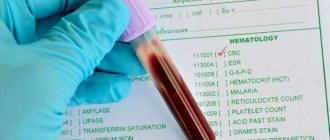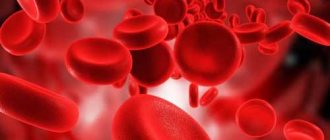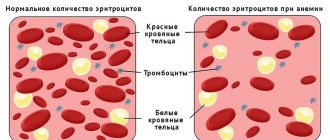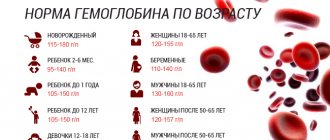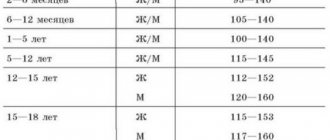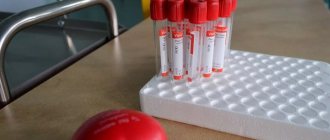Structure and forms of hemoglobin
What is hemoglobin?
Hemoglobin by its nature is a complex protein that consists of 4 polypeptide chains.
Depending on the type of chains, certain forms of hemoglobin are distinguished. In addition to chains, the molecule of this protein contains an iron ion. The hemoglobin molecule contains heme, which contains an iron ion, and globin, a protein component.
This transport protein is found in erythrocytes - red blood cells.
Photo: https://pixabay.com/illustrations/red-blood-cell-rbc-erythrocyte-1861640/
Forms
There are several forms of hemoglobin. It is worth dwelling in more detail on each of them.
Oxyhemoglobin
Oxyhemoglobin is a form of hemoglobin that is bound to oxygen. This form makes up 95-98% of hemoglobin in the blood. This type of transport protein is formed in the lungs and blood vessels coming from the lungs. Inhaled oxygen in the air penetrates through the alveoli of the lungs into the capillaries. Thus, oxygen-rich hemoglobin comes from the lungs.
Carbohemoglobin
Carbohemoglobin is the physiological form of hemoglobin. This is a type of protein that is associated with carbon dioxide. Normally, the content of this type of hemoglobin is 15–20%. Carbohemoglobin is formed by the exchange of oxygen for carbon dioxide in peripheral cells and tissues. It then transports CO2 to the lungs, where in the process it is exhaled into the environment.
There is more carboxyhemoglobin in venous blood, and accordingly, its color changes to darker.
Methemoglobin
Methemoglobin is a pathological form of hemoglobin, which is normally almost never found in healthy people. This type of hemoglobin contains Fe3+ instead of divalent iron. Such a protein cannot carry oxygen, and accordingly, disturbances occur.
The change in iron valency occurs under the influence of excess nitrites and nitrates, which can be found in excess in food products. In order for iron to regain its appearance, it can be treated with vitamin C.
Carboxyhemoglobin
Another pathological form of hemoglobin is carboxyhemoglobin. This form should not be confused with carbohemoglobin. Carboxyhemoglobin is hemoglobin bound to carbon monoxide. This occurs when a person inhales carbon monoxide. In the lungs, it binds to hemoglobin, taking the place of oxygen.
This type of hemoglobin can hardly “part with” CO. Thus, the exchange of gases is disrupted and a person may die if no measures are taken.
The pathological form of hemoglobin is HbS, which occurs in patients with sickle cell anemia.
Adult hemoglobin
It was previously indicated that depending on the type of chains, hemoglobin can also vary. Normally, in an adult, HbA or adult hemoglobin predominates. Its content in the blood is 80%. This hemoglobin contains 2 alpha chains and 2 beta chains.
There is also a small amount of erythrocyte transport protein in the blood, which contains 2 alpha subunits and two delta subunits. The content of such hemoglobin in the blood is no more than 2%.
Fetal hemoglobin
Children have another type of hemoglobin - fetal. Its difference from adult hemoglobin is in the composition of the chains. In children, hemoglobin consists of two alpha chains and two gamma chains. After the child is born, this hemoglobin will be replaced by the protein of an adult.
Also, an adult should not have fetal hemoglobin in the blood of more than 2%.
Myoglobin
The name of this protein is similar to hemoglobin. Myoglobin refers to proteins containing iron in its composition, as well as a protein part. The only difference from hemoglobin is that it is located in muscle tissue. There it acts as a depot for oxygen.
Building[edit | edit code]
Hemoglobin is a complex protein of the hemoprotein class, that is, the prosthetic group here is heme - a porphyrin core containing iron. Human hemoglobin is a tetramer, that is, it consists of 4 protomers. In an adult, they are represented by polypeptide chains α1, α2, β1 and β2. The subunits are connected to each other according to the principle of an isological tetrahedron. The main contribution to the interaction of subunits is made by hydrophobic interactions. Both α- and β-chains belong to the α-helical structural class because they contain exclusively α-helices. Each chain contains eight helical regions, designated A to H (N-terminus to C-terminus).
Heme is a complex of protoporphyrin IX, which belongs to the class of porphyrin compounds, with an iron(II) atom. This cofactor is non-covalently associated with the hydrophobic cavity of hemoglobin and myoglobin molecules.
Iron(II) is characterized by octahedral coordination, that is, it binds to six ligands. Four of them are represented by nitrogen atoms of the porphyrin ring, lying in the same plane. The other two coordination positions lie on an axis perpendicular to the porphyrin plane. One of them is occupied by the nitrogen of the histidine residue at position 93 of the polypeptide chain (section F). The oxygen molecule bound by hemoglobin is coordinated to iron from the reverse side and is enclosed between the iron atom and the nitrogen of another histidine residue located in the 64th position of the chain (section E).
In total, human hemoglobin has four oxygen binding sites (one heme for each subunit), that is, four molecules can bind simultaneously. Hemoglobin in the lungs at a high partial pressure of oxygen combines with it, forming oxyhemoglobin. In this case, oxygen combines with heme, joining the heme iron at the 6th coordination bond. Carbon monoxide also attaches to the same bond, entering into a “competitive struggle” with oxygen for the bond with hemoglobin, forming carboxyhemoglobin.
Functions of hemoglobin in the body
The main task of hemoglobin is to transport various gases in the blood, such as oxygen and carbon dioxide. Oxygen is necessary to maintain cell life. It is also important to take away the decay products of various substances, that is, not to accumulate “waste” in them.
Hemoglobin gives color to the blood: arterial blood is bright red, venous blood is cherry.
Hemoglobin acts as a buffer system, that is, it maintains the acid-base balance in the blood.
Four hemes + globin
The hemoglobin molecule is a complex protein (chromoprotein) consisting of four hemes and the globin protein. Heme, which has ferrous iron (Fe2+) at its center, is responsible for binding oxygen in the lungs. Combining with oxygen and turning into oxyhemoglobin
(HHbO2), it immediately delivers the component necessary for respiration to the tissues, and from there it takes carbon dioxide, forming
carbohemoglobin
(HHbCO2) to transport it to the lungs.
Oxyhemoglobin and carbohemoglobin are physiological hemoglobin compounds
.
The functional responsibilities of the red blood pigment in the human body also include participation in the regulation of acid-base balance, because it is one of four buffer systems that maintain a constant pH of the internal environment at the level of 7.36 - 7.4.
In addition, being localized inside red blood cells, hemoglobin regulates blood viscosity, prevents the release of water from tissues and, thereby, reduces oncotic pressure, and also prevents unauthorized consumption of hemoglobin when blood passes through the kidneys.
Hemoglobin is synthesized in erythrocytes, or rather, in the bone marrow, when they are still in the nuclear stage (erythroblasts and normoblasts).
When is it necessary to determine the level of hemoglobin in the blood?
Screening studies in adults
Photo: https://www.pexels.com/photo/white-plastic-syringe-1164531/
The hemoglobin level is one of the indicators determined in the CBC - a general clinical blood test. This study, together with the hemoglobin level, is one of the very first tests prescribed for any visit to the clinic.
It is the simplest and quite informative. If abnormalities are detected, the doctor will prescribe the patient to undergo other blood tests to clarify the state of health.
What symptoms are determined for?
Also, if there are some symptoms indicating a violation of the hemoglobin content in the blood, a general clinical blood test is prescribed.
A deficiency of oxygen, which hemoglobin carries, causes anemic syndrome. It manifests itself:
- dizziness;
- headache;
- weakness;
- fatigue;
- low performance;
- pallor of the skin, mucous membranes;
- possible fainting;
- increased heart rate.
Patients may also complain of tinnitus or spots before the eyes.
Also, the content of erythrocyte transport protein indicates whether there is enough iron in the body. Iron deficiency can manifest as sideropenic syndrome:
- dry skin;
- brittle nails;
- hair loss;
- perversion of taste sensations, for example, the desire to eat earth, chalk;
- changes in the nervous system.
If you suddenly notice similar clinical manifestations, you should consult a doctor and get blood tests.
Photo: https://pixabay.com/photos/shocked-shock-stop-annoyed-3079071/
What does a general blood test show?
No diagnosis can be made without a general blood test. Decoding the components of this analysis of indicators has several stages that make it possible to determine the complexity of the disease and the dynamics of its development with the treatment already carried out. The main thing in the analysis is the indicator of the presence of erythrocytes, leukocytes, hemoglobin level, leukocyte formula, ESR - erythrocyte sedimentation rate, hematocrit.
A low hemoglobin level can cause anemia. The indicator of erythrocytes indicates the presence of red blood cells in blood cells, which contain hemoglobin and serve as the transport of oxygen to tissues, perform a protective role, as they participate in immune and autoimmune processes, and absorb toxins. Red blood cells are also responsible for the delivery of amino acids from the digestive organs to the tissues.
The decoding indicates the indicator - hematocrit, which demonstrates the ratio of the volume of red blood cells to the volume of blood plasma. This indicator helps determine whether the hemoglobin connection process is disrupted or not. It is recorded as a percentage. Normal indicator: for women under 30 years old - up to 44.5%, men under 30 years old - 49%, for women 50-65 years old - up to 46%, for men - 49.5%. In children under 6 six months - up to 41%.
All of these indicators, taken together, help the doctor timely determine the onset of the disease and carry out timely treatment. The normal level of this substance in the male population is 130-160 g/l, in the female population - 120-140 g/l.
The essence of the method for determining hemoglobin level
The determination of this protein in the blood is carried out using the hemoglobin cyanide method. It consists of adding a special component to the blood that changes its color. The change in color intensity is recorded on a photocolorimeter - a special device that can calculate the optical density of a solution.
Then the concentration of hemoglobin in the blood is calculated according to a certain indicator.
Currently, the determination of this transport protein is carried out together with other indicators of a general clinical blood test on a hematological analyzer. The analyzer takes the required amount of blood from the test tube, then automatically calculates all the indicators. The results of the study are printed on paper and also sent to the electronic database of the healthcare institution.
Some types of hemoglobin are determined by specific methods.
For example, glycosylated hemoglobin is a protein combined with a carbohydrate component. Often used in the diagnosis of carbohydrate metabolism.
So, the determination of this protein is carried out using electrophoresis.
Normal hemoglobin level during pregnancy
Of course, it is difficult to say what the norm of a woman’s hemoglobin is during pregnancy; we can only say taking into account the duration of pregnancy and how the pregnancy itself proceeds. It is believed that the normal hemoglobin level for pregnant women is 120-160 g/l, but these are only average values, figures may vary.
If hemoglobin in the blood during pregnancy is 90-110 g/l, then this is a mild form of anemia.
If the hemoglobin level is 80 - 90 g/l, this is a moderate form of anemia.
If less than 80 g/l, this is a severe form of anemia.
When I was pregnant, my hemoglobin was 100 g/l, the doctor advised me to increase my hemoglobin with food. But my roommate’s hemoglobin was 80 g/l, the doctor said that it was impossible to do without medication. After all, low hemoglobin can provoke both delayed growth and development of the fetus and premature birth, so hemoglobin must be increased.
I’ll be honest, in a week I managed to increase hemoglobin only with food from 100 to 130 g/l, I ate meat, as my doctor said, that meat should only be eaten in the form of a chop or shish kebab, and you can also have pork and beef, since Prolonged heat treatment destroys the iron in meat. I also know that beef liver increases hemoglobin very well; I have already tested this on myself several times.
But, of course, there are cases when it is not possible to increase hemoglobin with the help of food, then you cannot do without the help of a doctor, because this may indicate serious disorders in the body. I also ate pomegranate, carrots and drank carrot juice. All these products helped me increase hemoglobin in my blood to normal. But the good thing is that during pregnancy, women often have to donate blood for analysis, so the hemoglobin will always be under the control of a gynecologist and in case of deviation from the norm, you will immediately receive advice and recommendations from the doctor.
Preparation
In order for the results to be as accurate as possible, it is recommended to follow simple rules when preparing for the study.
The material for research is blood. For a general clinical blood test, capillary blood is taken from a finger, as well as blood from a vein.
An important feature in preparing for a blood test is that the test must be taken on an empty stomach. That is, it is better to donate blood in the morning after an 8-10 hour fast after the last meal.
It is also recommended that you refrain from smoking for several hours before blood collection.
Stress and various emotional experiences can affect the results, so you should protect yourself from this.
It is also advisable to postpone physical activity until after blood sampling.
If the patient is taking any medications, such as sulfonamides, he should consult a doctor. Some groups of drugs may distort the results of the analysis.
Also, women during menstruation should not donate blood, as blood loss will be noticeable in a blood test. Blood can be donated after a week, when the concentration of indicators returns to normal.
Photo: https://pixabay.com/vectors/eat-drink-prohibited-forbidden-98633/
Low hemoglobin
This condition is called anemia (anemia). It is characterized by a sharp decrease in full-fledged red blood cells. If hemoglobin is low, cells and tissues begin to suffer from lack of oxygen.
Causes
- Significant blood loss. Among them there are obvious and hidden. Obvious blood losses include menstruation, bleeding during hemorrhoids, and blood loss during injuries or operations. Hidden blood loss can occur during gastrointestinal diseases.
- Lack of vitamins C and B12.
- Past infectious diseases or autoimmune diseases. Such diseases damage red blood cells, shortening their lifespan. Dysentery, salmonellosis, hepatitis, pneumonia, pyelonephritis, tuberculosis - all these diseases damage red blood cells.
- Helminths. They suck out huge amounts of B12, which is responsible for the absorption of iron.
- Unbalanced diet. The diet does not contain foods containing folic acid, protein, or B vitamins.
- Carrying a child and feeding. During these periods, a woman’s body consumes too much iron.
- Iron is not absorbed. This happens with gastritis, when the gastric mucosa becomes thinner, during dysbacteriosis, after undergoing surgical interventions in the gastrointestinal tract.
- Poor quality blood diseases.
- Gastrointestinal cancer.
- Blood pathologies.
- Bone marrow diseases.
- Chemotherapy sessions.
- Kidney failure.
- Stress.
- Diets.
- Liver disorders.
Symptoms
You can find out about low hemoglobin not only from a blood test. Almost always this is due to iron deficiency.
Some symptoms may indicate low hemoglobin:
- low pressure;
- lack of energy, lethargy;
- accelerated heartbeat;
- headache;
- brittle nails, spotting, lamination;
- hair loss;
- skin becomes dry;
- strange taste preferences (for example, most often such people like the smells of gasoline, paint, varnish, solvent);
- the skin becomes pale;
- changes in the color of the tongue - it becomes reddish and painful in appearance;
- slight increase in body temperature.
Treatment
Treatment always depends on the causes of deviations. If the disorder is caused by gastritis, you need to treat it; if the cause is bleeding, solve this problem.
In addition to local treatment, you are prescribed to take an iron supplement, which can only be prescribed by a doctor. Iron supplements are prescribed in moderate dosage, since an increased dose can cause the opposite effect - intolerance to the body. The average daily iron requirement for an adult is 300 mg. At the beginning of treatment, doctors give the maximum dosage, then after normalizing the hemoglobin level, the dose of the drug is reduced by two or three times.
When the level returns to normal, treatment should be continued for another two to four months.
After completing the course of treatment, you should definitely do prophylaxis two or three times a year. At this stage, you are prescribed to take about 40-60 mg of iron per day. An increase in hemoglobin will be observed only a month after taking the medication.
When low hemoglobin is associated with a lack of vitamin B12, vitamin injections are prescribed at a dosage of 300-500 mcg per day. When hemoglobin normalizes, which often happens in the fourth or sixth week, the dosage is reduced, and treatment with the drug also continues for about two or three months.
A special diet will help increase your level. List of foods that increase hemoglobin:
- meat products
- liver
- languages
- beef meat
- egg yolks
- buckwheat
- peas
- lentils
- tomatoes
- all types of onions
- pumpkins
- potato
- apple
- grenades
- pears
- apricots
- black currant berries
- cranberries
- nuts
- all types of dried fruits
- dried mushrooms
- salmon caviar
- dark chocolate
- green tea (promotes iron absorption)
Video: Low hemoglobin – School of Dr. Komarovsky
Analysis transcript
Hemoglobin norm
Next, information will be provided on how much normal hemoglobin is in women and men, as well as depending on the person’s age.
Table 1. Normal hemoglobin levels in the blood of men and women depending on age.
| Age and gender | Norm | |
| First two weeks of life | 135 – 200 grams per liter | |
| Two weeks – one month | 115 – 180 g/l | |
| 1 – 2 months | 90 – 130 grams per liter | |
| From two to six months | 95 – 140 g/l | |
| Six months - a year | 105 – 140 grams per liter | |
| From one to five years | 100 – 140 grams per liter | |
| From five years to twelve | 115 – 145 g/l | |
| Twelve – fifteen years | Girls | 112 – 152 grams per liter |
| Boys | 120 – 160 g/l | |
| Fifteen – eighteen years old | Girls | 115 – 153 g/l |
| Boys | 117 – 160 grams per liter | |
| Adults | Women | 120 – 155 g/l |
| Men | 130 – 160 grams per liter | |
Please note that the data in the table is indicative only. The results of the analysis are deciphered according to the data presented on the answer form of a specific laboratory. Also, the study of changes in hemoglobin levels over time should be carried out in the same laboratory, since data in different laboratories may differ slightly, but not significantly.
Low hemoglobin
Most often, among other abnormalities, a low level of hemoglobin in the blood is noted. A condition when the body's content of red blood cells and hemoglobin decreases is called anemia.
If the patient has anemia, then it is necessary to find out what caused this condition.
The reasons may be:
- blood loss is acute or chronic, hemoglobin deficiency is caused by a lack of red blood cells;
- as a result of a lack of certain vitamins, for example, folic acid or cobalamin (B12);
- lack of iron is accompanied by the occurrence of iron deficiency anemia;
- conditions in which destruction of red blood cells occurs (hemolysis). This may be caused by toxic compounds in the blood or medications;
- some chronic diseases;
- genetic disorders that lead to a defect in enzymes involved in the metabolism of iron and red blood cells;
- disruption of the formation of transport protein chains leads to a decrease in its level in the blood. An example of such a disease would be thalassemia. Normally, an adult has two alpha and two beta chains in hemoglobin. In thalassemia there can be different variations: all four alpha or beta chains, or only 3 alpha and one beta chains, and vice versa.
Anemia can be classified according to severity. The degree will depend on the hemoglobin content in the blood:
- mild anemia – hemoglobin not lower than 90 grams per liter;
- moderate – hemoglobin 70 – 90 grams per liter;
- severe severity will occur when the hemoglobin concentration is less than 70 grams per liter.
Increased hemoglobin levels
High concentrations of this transport protein can also be found in patients. As a rule, the doctor, noticing this deviation, says that the blood is thick. And this can be dangerous for the body.
A high hemoglobin content is possible with a large number of red blood cells in the blood. This is observed in polycythemia, a condition when the content of all three types of formed elements increases:
- red blood cells;
- white blood cells;
- platelets.
Photo: https://foter.com/fff/photo/34146253130/626327768a/
An increased number of platelets threatens the development of blood clots in the body. A clot can block blood flow, causing cells to die. In some cases, death can be avoided.
An increase in the number of red blood cells may occur due to an increase in erythropoietin levels in kidney pathology or as a result of a compensatory mechanism in the bone marrow in malignant blood diseases.
If abnormalities in hemoglobin levels are detected, additional blood tests must be performed to clarify the reasons. These include:
- indicators characterizing iron metabolism in the body (transferrin, ferritin, OZHS and others);
- blood levels of B9 and B12;
- molecular genetic research to confirm some genetic changes in enzymes and so on;
- bone marrow puncture.
Normal hemoglobin levels
The table will tell you how much hemoglobin should be in the blood. Based on these data, therapists make comparisons, which allows them to identify even minor disorders in infants
What information will be important to patients?
| Age | Norm |
| 0-14 days | 135-200 |
| 14-30 days | 115-180 |
| 1-6 months | 90-140 |
| 6-12 months | 105-140 |
| 1-5 years | 100-140 |
| 5-12 years | 120-150 |
| 12-15 years | 120-160 |
| 15-18 years old | 117-166 |
| 18-65 years old | 131-173 |
| Over 65 years old | 125-175 |
Depending on age, average indicators vary greatly. The reason is hormonal levels, which need to be taken into account due to the immune system. This factor remains fundamental, so it cannot be ignored. Practice shows how difficult moments therapists encounter when monitoring people’s conditions over time.
The newborn's indicators remain high. This shows how fast his blood is moving and all his organs are working. After this, the data begins to constantly change, which often affects the condition of the child and adolescent. Only in adulthood does the level become constant, so it can be used to quickly determine the occurrence of certain diseases.
How to increase the level of hemoglobin in the blood?
The doctor should tell the patient how to adjust the hemoglobin level. Self-prescription of any medications can aggravate the situation and lead to deterioration of health.
The most that patients can do on their own is to change their diet. If there is a lack of hemoglobin, the amount of foods containing iron should be increased. If there is an excess, on the contrary, you should stop eating foods rich in iron for a while, then check your hemoglobin again. You should also drink more water. The blood will be slightly diluted, which will again affect the results of the OAC.
What foods are rich in iron? These ones:
- meat;
- pomegranate;
- legumes;
- nuts;
- dried fruits;
- greenery;
- buckwheat and others.
Photo: https://www.pexels.com/
Prevention
An increase or decrease in hemoglobin levels means health problems and various serious diseases. To avoid this, follow a number of rules:
- timely blood donation. At least once a year it is necessary to conduct a scheduled analysis that will help monitor Hb levels;
- to give up smoking. Tobacco smoke that a person inhales binds hemoglobin with carbon monoxide, which reduces the protein’s ability to deliver oxygen to the body’s cells;
- complete nutrition. Problems with hemoglobin can occur due to strict diets. Protein-rich foods (meat, fish, eggs, cottage cheese, cheese) help prevent anemia. It is recommended to increase the consumption of foods rich in iron - oatmeal, millet, buckwheat porridge;
- In case of gastrointestinal diseases, carefully monitor your health, as bleeding is possible during periods of exacerbation. This reduces the level of Hb in the blood.
Limits of normal values
Well, perhaps you don’t need to describe the hemoglobin norm. This is one of the indicators, the normal values of which most people will name without hesitation. However, we would like to remind you that the norm in women is slightly different from that in men, which is understandable from a physiological point of view, because the female sex loses a certain amount of blood every month, and at the same time iron and protein.
In addition, the level of hemoglobin cannot remain unchanged during pregnancy, and although fetal tissue is mainly supplied with oxygen by fetal (HbF) hemoglobin, its level in the mother also decreases slightly (!). This happens because plasma volume increases during pregnancy and the blood thins (in proportion to the decrease in red blood cells). Meanwhile, such a phenomenon is considered a physiological condition, so there can be no talk of any significant drop in Hb levels as normal. Thus, the following values are taken for normal hemoglobin, depending on gender and age:
- In women from 115 to 145 g/l (during pregnancy from 110 g/l);
- In men, from 130 to 160 g/l;
- In children, the hemoglobin content is normal, as in adults: before birth, HbA begins to be synthesized, which by the year of life practically replaces the fetal hemoglobin that served the child during intrauterine development.
When considering hemoglobin, one cannot ignore other indicators that indicate whether hemoglobin sufficiently fills red blood cells, or whether they circulate lightly, without Hb.
The color index (CI), indicating the degree of saturation, can have the following values:
- 0.8 – 1.0 (red blood cells are normochromic – no problem);
- Less than 0.8 (hypochromic - anemia);
- More than 1.0 (Er hyperchromic, reason?).
In addition, the saturation of red blood cells with pigment can be indicated by such a criterion as SGE ( average
Hb in 1 erythrocyte
, which when examined in an automatic analyzer is designated
MCH
), its norm is from 27 to 31 pg.
However, the hematology analyzer also calculates other parameters that reflect the state of red blood (hematocrit, average hemoglobin content in erythrocytes, average volume of erythrocytes, indicator of their heterogeneity, etc.).
Why does the hemoglobin level change?
Hemoglobin levels depend to some extent on:
- Season (it decreases in the fall, probably because people harvest and prefer plant foods),
- Diet: vegetarians have lower Hb;
- Climate and terrain (where there is little sun, anemia is more common, and in high mountain areas hemoglobin increases);
- Lifestyle (active sports and intense physical work for a long time increase hemoglobin);
- Oddly enough, both clean fresh air and smoking affect Hb levels to almost the same extent (they increase it). Most likely, for smokers this indicator includes hemoglobin modified by tobacco smoke, so those who like to relax with a cigarette seem to have no reason to be satisfied with the tests, but there is an opportunity to think: what does hemoglobin carry in the red blood cells of a smoker?
Methods for studying hemoglobin in a clinical laboratory
To determine the hemoglobin index (high, low values), a blood test for hemoglobin is used.
Blood for this analysis is taken from a peripheral capillary sample (from a finger).
When donating venous blood, the indicator of this protein has slightly reduced numbers.
There are several methods of clinical laboratory testing of blood for hemoglobin:
- Colorimetry is an indicator of the color saturation of the reaction to hemoglobin concentration,
- Method of gasometry of biological fluid: a sample for a blood test is filled with gas, after which the volume and degree of absorption of this gas by hemoglobin molecules is measured,
- Determination of iron ions in the blood - this technique allows you to determine the correspondence of the volume of iron ions to the concentration of hemoglobin.
The gasometry method and the iron determination method are the most accurate tests, but they are labor-intensive and not every clinical laboratory undertakes to carry them out, so the often used method is colorimetry.
Diagnostic study of hemoglobin in the blood
Based on the results of a general blood test, it is possible to determine the level of low hemoglobin, which causes anemia in the preclinical stage, when the patient does not feel signs of illness.
The analysis shows the following composition in the blood:
- The quantitative index of erythrocytes is reduced,
- Large red blood cells
- Color level not less than 1.1,
- Hemoglobin index is low,
- Poor quality of red blood cells in the molecules there are remnants of the nucleus,
- Low reticulocyte count,
- Low neutrophil ratio,
- Reduced platelet count,
- Deviation from the norm towards a strong increase in all cells.
After checking the blood composition using a general analysis, the doctor may prescribe a more complete examination to identify the cause of this decrease.
Biochemistry reveals an increase in the blood test: bilirubin, with an increased index.
Tests are also carried out: general urine analysis, stool testing for worms, x-ray of the gastrointestinal tract, as well as ultrasound of internal vital organs.
An elevated hemoglobin index is detected by clinical hemoglobin testing.
Further diagnostic tests depend on the degree of increase. If the increase is slight, then it can be corrected with diet.
If the index is too high, then the doctor prescribes a number of additional studies, depending on the severity of the symptoms.
Standard indicator in a child’s body
The normal level of hemoglobin in the blood depends on the age of the baby. Normal indicators are marked according to age in the table:
| Children's age | Hemoglobin protein content (g/l) |
| less than 3 calendar days from birth | 145,0 – 225,0 |
| up to 7 calendar days | 135,0 – 215,0 |
| 14 calendar days | 125,0 – 205,0 |
| 30 days from the birth of the baby | 100,0 – 180,0 |
| 30 days from the birth of the child | 90,0 – 140,0 |
| from 90 – 180 calendar days | 95,0 – 135,0 |
| from 6 – 12 calendar months | 100,0 — 140,0 |
| from 12 months to 2 years | 105,0 – 145,0 |
| 2-3 years old child | 105,0 — 145,0 |
| up to 7 years of age | 110,0 – 150,0 |
| 7th anniversary – 15th anniversary | 115,0 – 155,0 |
| teenagers over 16 calendar years | 120,0 – 160,0 |
By the end of 12 months from the moment of birth, fetal hemoglobin is completely destroyed and is replaced by hemoglobin, which is present in every person older than one year from the moment of birth.
Immediately after birth, hemoglobin concentration is highest. This concentration is fetal, and in its structure this protein differs from adult hemoglobin.
If the fetal type of hemoglobin is elevated and detected at an older age, it means that the child’s body is not developing properly, or the presence of a serious pathology of the hematopoietic system in this body.
Timely diagnosis of a small child’s body helps to identify disturbances in hemoglobin indices at the initial stage of pathology and makes it possible to prevent the development of anemia in the child’s body.
Normative indices in the adult body
| normal index in the male body | 130.0 - 150.0 g/l |
| among women | 120.0 - 135.0 g/l |
| in women during pregnancy | 115.0 - 110.0 g/l |
| over 50 years of age | norm - a decrease of 5.0% from the level in an adult body |
During pregnancy, the coefficient of this protein decreases. This depends on the load on the body of fetal development, and hemoglobin is also necessary for the intrauterine formation of the unborn baby. In women, the hemoglobin concentration index fluctuates during menstruation.
When deciphering hemoglobin indicators, it is necessary to take into account the chromaticity index (the color indicator of the filling of red blood cell molecules).
Values of this indicator:
- 0.80 1.0 normochromic filling of red blood cells (ideal indicator, with normal iron levels),
- Less than 0.80 hypochromic filling (anemia),
- More than 1.0 hyperchromic filling of erythrocytes (it is necessary to determine the cause of this deviation).
Also, when coloring, the hemoglobin content in one red blood cell is also taken into account. The norm of hemoglobin in one erythrocyte molecule is from 27 pg to pg.
There is little hemoglobin
“I have low globin,” this is how a woman put it, having stayed too long in the maternity hospital and explaining the essence of the problem to curious neighbors. Low hemoglobin, unlike high hemoglobin, occurs quite often, everyone is actively fighting it, using not only medications containing iron and B vitamins, but also a wide range of folk remedies and products that increase hemoglobin.
Reduced or low hemoglobin along with a decrease in the number of red blood cells is called anemia
(anemia), for men anemia is considered to be a drop in Hb level below 130 g/l, women are considered anemia if the hemoglobin content in red blood cells becomes less than 120 g/l.
In the diagnosis of anemia, hemoglobin plays a decisive role, since red blood cells do not always have time to decrease (in mild forms). It is appropriate to name the main forms of anemia, because this concept is not limited to iron deficiency anemia (IDA). Thus, 6 main groups are most often considered:
- Acute posthemorrhagic anemia, which occurs after massive blood loss. It is clear that the causes of low hemoglobin here will be injuries, wounds, and internal bleeding.
- Iron deficiency anemia is the most common, since a person does not know how to synthesize iron, but takes it from the outside with foods rich in this element. You may not know or know about IDA for a long time if you do not take a blood test for Hb, Er, CP, etc.
- Sideroachrestic anemia, associated with impaired utilization and synthesis of porphyrin and the accumulation of excess iron as a result. The cause of low hemoglobin in this case may be a hereditary factor (lack of an enzyme that includes iron in heme) or an acquired pathology resulting from lead intoxication, alcoholism, cutaneous porphyria, or as a consequence of treatment with anti-tuberculosis drugs (tubazid).
- Megaloblastic, B12 and/or folate deficiency (Addison-Biermer disease). This form was once called malignant anemia.
- Hemolytic anemia, united by a common feature - the accelerated breakdown of red blood cells, which instead of 3 months live only a month and a half.
- Anemia associated with inhibition of erythroid proliferation, for example, its displacement by tumors, aplastic anemia during treatment with cytostatics or exposure to high doses of radiation.
There are quite a few conditions that have the symptom of low hemoglobin, each of them has its own mechanism of development and prerequisites for its occurrence, but we will consider the most common causes and symptoms of this pathology.
Why does the color of blood fade?
The reasons for low hemoglobin, in addition to climate or pregnancy status, can arise from many circumstances:
- Heavy prolonged menstruation, nose, gum and dental bleeding, as well as massive blood loss (red blood cells leave and take hemoglobin with them).
- Nature of nutrition. Lack of food containing iron, vitamins or facilitating their absorption from other foods. Food addictions that inhibit the absorption of iron in the digestive tract, for example, foods containing calcium (milk, cheese, white bread).
- High needs for vitamins and iron (children under 2 years old, adolescents, pregnant women).
- Resorption insufficiency (impaired absorption in the gastrointestinal tract), caused by the presence of diseases of the gastrointestinal tract (gastroduodenitis, enterocolitis, resection of the stomach or part of the intestine).
- Infections are acute and chronic.
- Fast growing tumors.
- Blood diseases.
- Helminthiases.
- Liver diseases.
- Alcoholism.
- Collagenosis (systemic lupus erythematosus, rheumatoid arthritis).
- Food and chemical poisoning.
- Hereditary factor (defects of certain enzymes, membranopathy, hemoglobinopathies).
- Long-term use of certain medications.
Obviously, if you list the reasons for low hemoglobin for each form of anemia, and then add them up, there will be much more of them.
How does anemia manifest?
Symptoms indicating low hemoglobin, as well as the reasons: there are general ones, and there are purely specific ones. For example, the deposition of iron in places unusual for it in sideroachrestic anemia leads to the appearance of various pathologies: diabetes mellitus (Fe accumulates in the pancreas), cirrhosis of the liver, heart failure (in the heart), eunuchoidism (in the gonads), but this does not mean that such troubles will come out in other forms.
Meanwhile, low hemoglobin can be assumed based on some signs:
- Pale (sometimes with a yellowish tint), dry skin, scratches that heal poorly.
- Seizures in the corners of the mouth, cracks on the lips, painful tongue.
- Brittle nails, split ends, dull hair.
- Muscle weakness, fatigue, drowsiness, lethargy, depression.
- Decreased concentration, flashing “flies” before the eyes, intolerance to stuffy rooms.
- Drooling at night, frequent urge to urinate.
- Decreased immunity, poor resistance to seasonal infections.
- Headaches, dizziness, possible fainting.
- Shortness of breath, attacks of rapid heartbeat.
- Enlarged liver and/or spleen (a sign that is not characteristic of all forms).
Clinical manifestations of anemia increase as the process develops and progresses.
“Harmful” abilities of hemoglobin
Even better than with oxygen, hemoglobin binds with carbon monoxide (CO), transforming into carboxyhemoglobin
(HHbCO), which is a very strong compound that significantly reduces the physiological abilities of red blood pigment. Everyone knows how dangerous it is for a person to stay in a room filled with carbon monoxide. It is enough to inhale only 0.1% CO with the air so that 80% of Hb combines with it and creates a strong bond, leading to the death of the body. It should be noted that smokers are constantly at risk in this regard; in their blood, the content of carboxyhemoglobin is 3 times higher than normal (N - up to 1%), and after a deep puff it is 10 times higher.
A very dangerous condition for the hemoglobin molecule is the replacement of divalent iron in heme (Fe2+) with trivalent iron (Fe3+) with the formation of a form dangerous to health - methemoglobin
. Methemoglobin sharply inhibits the transfer of oxygen to organs, creating conditions unacceptable for normal life. Methemoglobinemia occurs as a result of poisoning with certain chemicals or is present as a hereditary pathology. It may be associated with the transmission of a defective dominant gene or due to recessive inheritance of a special form of enzymopathy (low activity of an enzyme capable of restoring metHb to normal hemoglobin).
Such a necessary and wonderful complex protein in all respects as hemoglobin, localized in red blood cells, can become a very dangerous substance if for some reason it is released into the plasma. Then it becomes very toxic, causing oxygen starvation of tissues (hypoxia) and poisoning the body with its breakdown products (bilirubin, iron). In addition, large Hb molecules, which are not destroyed and continue to circulate in the blood, enter the renal tubules, close them and thereby contribute to the development of acute kidney injury (acute renal failure).
Such phenomena, as a rule, accompany severe pathological conditions associated with disorders in the blood system:
- DIC syndrome;
- Hemorrhagic shock;
- Congenital and acquired hemolytic anemia; (sickle cell, thalassemia, autoimmune, toxic, Moshkovich disease, etc.);
- Transfusion of blood incompatible with group erythrocyte antigens (AB0, Rh).
Disturbances in the structural structure of hemoglobin are called hemoglobinopathies in medicine. This is a range of hereditary blood diseases that includes such well-known pathological conditions as, for example, sickle cell anemia and thalassemia.
What determines the increase in hemoglobin molecules in the blood?
Laboratory clinical studies provide results in accordance with standard indicators of an increased hemoglobin index, or its deficiency in the body.
The causes of increased hemoglobin are:
- Sports with great activity and loads increase this protein.
- Living for a long period of time in an area that is located high above sea level, there is a significant saturation of oxygen, which leads to high blood pressure and an increased content of cells containing hemoglobin in the blood,
- The level of hemoglobin increases with a large loss of fluid from the body, with burns over a large area, with intoxication of the body, which is accompanied by long-term diarrhea and severe vomiting,
- Accumulation by erythrocyte cells of a larger supply of red protein compound in pathologies in the body: cardiac and pulmonary failure, myocardial infarction, coronary syndrome in the acute stage of the onset and development of pathology,
- Polycythemia disease,
- In the disease erythremia, malignant oncological neoplasms in the cells of the blood germ,
- Defects of the heart organ,
- Pathologies of the pulmonary organ that lead to bronchial-type asthma,
- Incorrect synthesis of red pigment protein molecules and erythrocyte molecules by the liver, and blocking of formed working erythrocytes into the blood plasma.
A high hemoglobin index is just as dangerous as its low level in blood cells. With an increased glycated hemoglobin ratio, attention must be paid to treating the underlying cause of diabetes mellitus.
Increased hemoglobin in women can provoke uterine bleeding.
The drug therapy regimen is prescribed individually by an endocrinologist. Treating diabetes on your own can lead to coma and death.
A decrease in the high hemoglobin index requires establishing the etiology of this increase and treating the root cause of the high hemoglobin content in the blood plasma using adequate methods.
Symptoms of a high hemoglobin index
Characteristic symptoms of a high content of red blood cell molecules filled with hemoglobin in the blood:
- Red complexion
- Headache,
- Head spinning
- High blood pressure,
- Bleeding from the sinuses,
- Increased heart rate.
Symptoms of a low plasma hemoglobin index
Anemia can occur as an independent pathology or as a secondary pathology.
What is considered low hemoglobin? According to WHO, the norm for red protein in adult men is no less than 130.0 grams per liter of blood, and in women no less than 120.0 g/l.
A decrease in this value occurs due to an increase in leukocytes in the plasma, an accelerated ESR rate, and the pathology of anemia develops.
Anemia can also occur with diseases of the internal organs and hematopoietic system of the human body.
Symptoms of low hemoglobin ratio:
- Severe fatigue of the body,
- Drowsiness,
- Dizziness, sometimes severe, which leads to vomiting from the body,
- Rapid degree of body fatigue,
- Impaired contraction of the heart muscle
- Reduced blood pressure (hypotension),
- Pain in the head, sometimes severe and sharp,
- Pale skin color,
- Blueness on the face
- Fainting state.
With the development of iron deficiency type of anemia, symptoms characteristic of this pathology are present:
- Dryness of the epidermis,
- The eyeballs have a faded yellowish tint,
- Shortness of breath on exertion and in a relaxed state,
- Muscle tone is weak,
- increased pulsation of the heart muscle (palpitations),
- The spleen increases in size,
- Changes in stool color occur
- Increased sweating, sweat that is sticky to the touch and cold,
- Severe nausea progressing to prolonged vomiting,
- Feeling of numbness and tingling in the fingers of the upper and lower extremities,
- Cracks in the corners of the mouth,
- Detachment of the nail plate and its fragility,
- Dullness and fragility of scalp hair,
- Hair loss,
- Impaired functioning of the olfactory organs,
- Tongue tingling
- Constant thirst
- Noise in ears,
- Sleep disturbances
- Anorexia: complete or partial lack of appetite,
- Disruption in the menstrual cycle in women, or complete absence of menstruation for a long period of time,
- Male sexual weakness.


